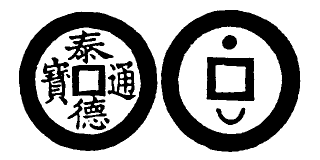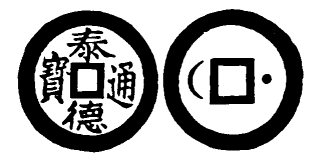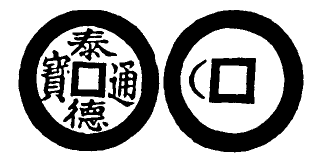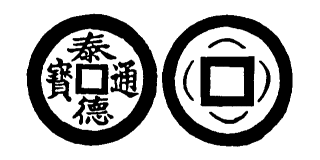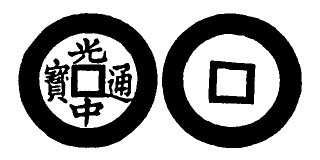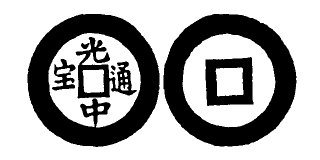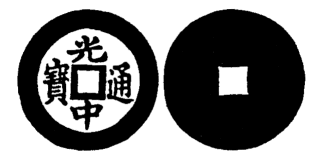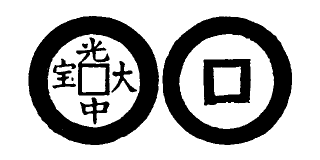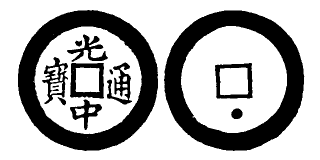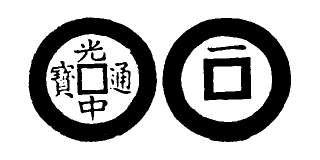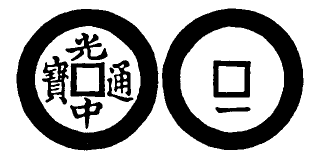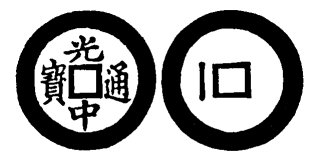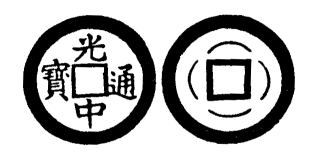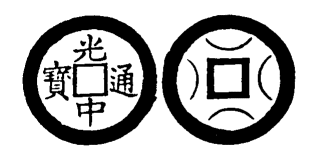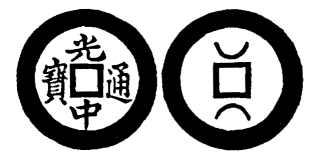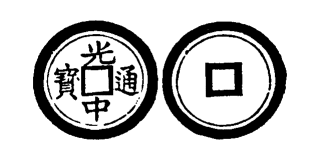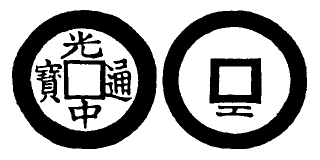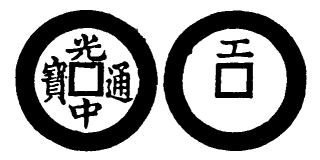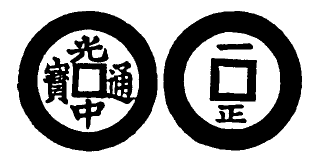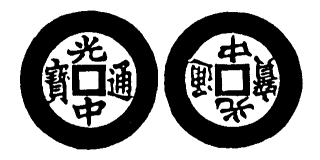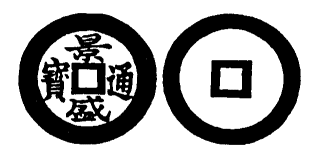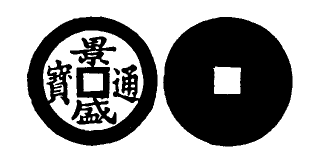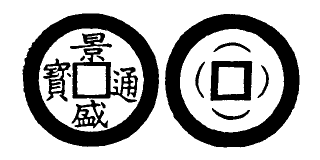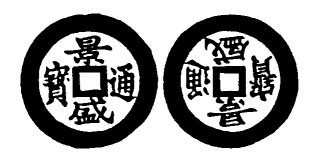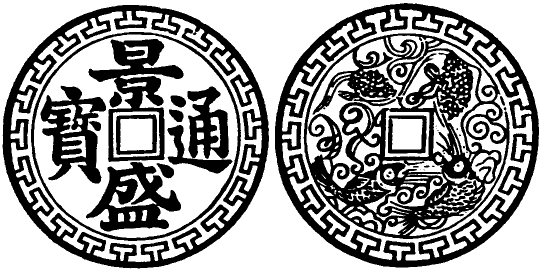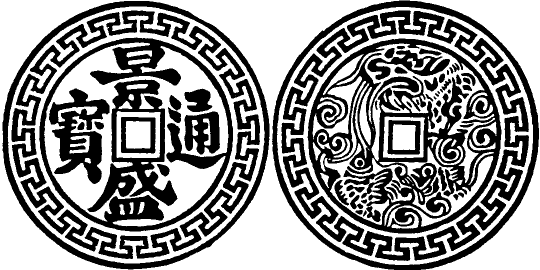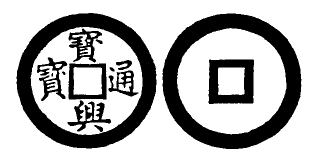Coins and Banknotes of Vietnam
and French Indochina
XIX. The 西山 Tay-son Rebellion. 1764-1801.
Annam is certainly the country in which there have been the greatest number of rebellions, and the most important one is without doubt that of the Western Mountaineers, who rebelled in 1764 in the province of 平定 Binh-dinh, and soon afterwards became the masters of the whole Annamese territory.
There exist two different versions of the origin of this great rebellion. According to the Annamese version, as given by Mr. PETRUS VINH-KY, there lived in the country of Binh-dinh a Tunquinese family of prisoners of war who had formerly inhabited 爻安 Nghe-an, and who were taken down to Cochinchina by the NGUYEN armies during the reign of 神宗 Than-tong. One of the members of this family, called 阮文岳 NGUYEN VAN-NHAC, rose to the position of Bien-lai or Treasurer of the Customs station at Van-don. This Nguyen Van-nhac lost heavy sums by gambling, and to pay these amounts he embezzled Government money under his charge. Fearing discovery, he fled to the Tay-son mountains, and there soon collected around him about three thousand criminals, thiefs and pirates. He appointed his two brothers 文惠 VAN-HUE and 文錄 VAN-LU lieutenants of this army, whose first operations were to attack and plunder the Customs stations on the frontier and to pillage the rich families in the country. The men of that army took the name of 西山 Tay-son. and the revolt is known by the name of the Rebellion of the Western Mountaineers.
The Tay-son rebels successfully resisted the armies sent against them, emboldened by the victories they obtained, until they seized the citadel of Binh-dinh, having entered its walls by a stratagem somewhat similar to that of the famous wooden horse of the siege of Troy. The rebel chief however soon found himself hard pressed on the North by the royal troops of the LE Dynasty, under the command of Trinh-sum, and on the South by those of the Lords NGUYEN. VAN-NHAC thought it prudent to cast in his lot with that of the Lords Trinh, by whom he was soon employed to expel the Nguyen from the country. This end being obtained, he was created 鄭靖王 Trinh-thanh Vuong, in 1775, and appointed by royal authority Governor of Qnang-nam. In 1776 the war against the Nguyen was continued and their last King 睿宗 DUE-TONG and his son were made prisoners and beheaded in Saigon. In 1777 Van-nhac took advantage of the royal armies having returned to Tunquin to proclaim himself king of Cochinchina under the name of 泰德 THAI-DUC.
But at the same time a nephew of King DUE-TONG, the last representative of the NGUYEN family, raised his standard against the Tay-son rebels, and after many contests in which success and reverses were equally divided, he put an end to the rebellion, and in 1801 occupied the throne of Annam, taking 嘉隆 GIA-LONG as the name of his reign and founding the present Dynasty of the country.
The Chinese version of the Tay-son revolt is that the Lords TRINH, in order to take advantage of every possible way of destroying the power of the NGUYEN, bribed two of their officials, VAN-NHAC and VAN-HUE, and commanded them to revolt and take the capital Hue, and thus annihilate the race of their rulers. It is easy to perceive that this version is not a correct one, as it was Lord Trinh himself who took Hue and subsequently received the submission of the Tay-son.
We have seen that in 1777 VAN-NHAC proclaimed himself king and appointed his brother HUE commander-in-chief. Rivalry soon broke out between the two brothers, and a fight ensued between their two armies, but a common danger brought them together again. In order to prevent such differences for the future, they divided, in 1785, the territories already conquered into three kingdoms, each kingdom to be governed by one of the brothers. The following table will give an exact idea of this division.
| NAME. | ACCESSION. | NAME OF REIGN. | YEAR OF ADOPTION OF NAME OF REIGN. |
| First brother. | |||
| 阮文岳 Nguyen Van-nhac | 1764 | 泰德 Thai-duc | 1777 |
| Second brother. | |||
| 阮文惠 Nguyen Van-hue | 1785 | 光中 Quang-trung | 1786 |
| 阮文纘 Nguyen Van-toan | 1791 | 景盛 Canh-thinh | 1791 |
| 寶興 Bao-hung | 1800 | ||
| Third brother. | |||
| 阮文錄 Nguyen Van-lu | 1785 | 東定 Dong-dinh | 1785 |
The above notices will be sufficient to give an idea of the importance of the Tay-son rebellion. These rebels occupied in fact the whole of Annam, and the Chinese Emperor K'IEN-LUNG, after having invaded that country and failed to restore the throne of the Last LE Prince, recognized Van-hue as king, in 1789, and received him in his summer palace at Jehol.
The story of the contest between the armies of the Tay-son and those of GlA-LONG is a long one, and of no special interest, as it merely consists of a long list of battles in the Annamese style, in which appears as victor the very same chief who the day before had been defeated. Gia-long had the good fortune of being assisted by the Bishop of Adran who caused the French Government to interfere for the first time with the affairs of Annam. In 1801 Quinhon, the last stronghold of the rebels, fell into his hands, and thus ended the most formidable rebellion that has ever devastated Annam.
VAN-NHAC took the title of 大皇帝 Dai-hoang-de or Emperor, and occupied the territories of the 廣南 Quang-nam to the South of 平定 Binh-dinh, his capital being at the port of Quinhon. He died in 1792 leaving as accessor his son 思朝 Tu-trieu, who was immediately deposed and some time afterwards murdered by his uncle Hue.
No. 177. (Barker: 91.3-91.4)
Obverse: 泰德通寶 Thai-duc-thong-bao.
Reverse: plain. Copper.
No. 178. (Barker: 91.7)
Obverse: Same as before.
Reverse: The sun and the moon above and below the square hole. Copper.
No. 179. (Barker: 91.5)
Obverse: Same as No. 177.
Reverse: The sun and the moon on the right and left of the hole. Copper.
No. 180. (Barker: 91.6)
Obverse: Same as No. 177.
Reverse: The sun above, and the sun and moon together below the hole. Copper.
No. 181. (Barker: see 91.6)
Obverse: Same as No. 177.
Reverse: The moon on the left of the hole. Copper.
No. 182. (Barker: 91.8)
Obverse: Same as No. 177.
Reverse: The moon below the hole. Copper.
No. 183. (Barker: none)
Obverse: Same as No. 177.
Reverse: Four crescents round the hole. Zinc.
No. 184. (Barker: 91.1-91.2)
Obverse: Same as No. 177.
Reverse: The characters 七分 That-phan, indicating the weight of the cash. Copper.
All the above coins were issued by the rebel chief 阮文岳 NGUYEN VAN-NHAC (1777-1792). Except the one made of zinc, they are all of red copper imported into Annam from Japan.
VAN-HUE occupied the whole of Tunquin and a part of Cochinchina, having his capital at first in Hue and afterwards in 中都 Trung-do, in the province of 爻安 Nghe-an. In December of 1789 he received his investiture and seal from the Emperor of China, and being thus recognized as king of Annam, he sent to Peking the amount of two tributes. He died in 1791, and in the following year his son and successor 文纘 VAN-TOAH incorporated with his kingdom the territories belonging to the son of VAN-NHAC.
No. 185. (Barker: 93.2-93.18)
Obverse: 光中通寶 Quang-trung-thong-bao.
Reverse: plain. Two kinds of metal were employed in the manufacture of this cash, viz: Copper and tin.
No. 186. (Barker: 93.9)
Same as before, but with the character Bao written as follow: 宝.
No. 187. (Barker: see 93.16)
Same as No. 185, but without any rim on the reverse.
Note: The images for No. 186 and No. 187 were swapped in the original Toda's publication.
No. 188. (Barker: 94.1-94.4)
Obverse: 光中大寶 Quang-trung-dai-bao.
Reverse: plain. Red copper.
No. 189. (Barker: none)
Obverse: Same as No. 185.
Reverse: A dot below the hole. Copper.
No. 190. (Barker: 93.24)
Obverse: Same as No. 185.
Reverse: A straight line above the hole. Red copper.
No. 191. (Barker: 93.25)
Obverse: Same as No. 185.
Reverse: A line below the hole.
No. 192. (Barker: none)
Obverse: Same as No. 185.
Reverse: A line on the left of the hole.
No. 193. (Barker: 93.28)
Obverse: Same as No. 185.
Reverse: Four crescents round the hole. Tin mixed with a small quantity of copper.
No. 194. (Barker: 93.29-93.31)
Obverse: Same as No. 185.
Reverse: Four crescents round the rim. Same metal as above.
No. 195. (Barker: none)
Obverse: Same as No. 185.
Reverse: Two crescents above and below the hole. Same metal as above.
No. 196. (Barker: see 93.19-93.20)
Obverse: Same as No. 185.
Reverse: A line round the rim, similar to the one on the obverse. Tin. This coin is a little smaller than the others.
No. 197. (Barker: 93.27)
Obverse: Same as No. 185.
Reverse: The character 工 Cung, for the Board of Public Works, below the hole. Tin.
No. 198. (Barker: none)
Same as before, but with the character 工 Cung of the reverse above the hole. Copper.
No. 199. (Barker: none)
Obverse: Same as No. 185.
Reverse: The character 一 Nhat. one, denoting the vaIue of the cash, above the hole, and below the character 正 Chanh, the meaning of which has already been explained. Copper.
No. 200. (Barker: 93.23)
Obverse: Same as No. 185.
Reverse: The characters 山南 Son-nam, written in the 隸 Le style. They denote the province in which the coin was made. Red copper.
No. 201. (Barker: none)
Obverse: Same as No. 185.
Reverse: Same inscription as on the obverse, but with the characters upside down.
The above coins, from No. 185 to 201, were issued by the rebel chief 阮文惠 Nguyen Van-hue (1786-1791).
No. 202. (Barker: 95.1-95.10)
Obverse: 景盛通寶 Canh-thinh-thong-bao.
Reverse: plain. Tin.
No. 203. (Barker: see 95.2-95.20)
Obverse: Same as before.
Reverse: without rim. Copper.
No. 204. (Barker: none)
Obverse: Same as No. 202.
Reverse: A straight line below the hole. Copper.
No. 205. (Barker: none)
Obverse: Same as No. 202.
Reverse: with four crescents round the hole. Tin mixed with copper.
No. 206. (Barker: none)
Obverse: Same as No. 202, with a line round the rim.
Reverse: A line round the rim. Tin.
No. 207. (Barker: none)
Obverse: Same as No. 202.
Reverse: The inscription 光中通寶 Quang-trung-thong-bao, referring to the rebel Quang-trung. The characters are upside down. Tin.
No. 208. (Barker: none)
Obverse: Same as No. 202.
Reverse: Same inscription us on the obverse, with the characters upside down. Tin.
No. 209. (Barker: see 209.1-209.2)
Obverse: Same as No. 202, but with plain rim.
Reverse: Two fish and two flowers. On the rim the same design as on the obverse. Yellow copper.
No. 210. (Barker: 209.1-209.2)
Obverse: Same as No. 209, the design on the rim varying a little.
Reverse: A dragon and a fish. Yellow copper.
The coins numbered 202 to 210 were issued by the rebel 阮文纘 NGUYEN VAN-TOAN (1791-1800). Nos. 209 and 210 were cast for the purpose of being given away as medals.
No. 211. (Barker: 97.1-97.2)
Obverse: 寶興通寶 Bao-hung-thoug-bao.
Reverse: plain. Copper.
In 1800 Van-toan changed the name of his reign to Bao-hung and issued this coin, of which a very small quantity only was cast, as this rebel soon disappeared from Annam.
VAN-LU was a bonze and his reign but a short one. Proclaimed king of 平順 Binh-thuan and lower Cochinchina in 1785, he established his capital in Saigon, whence he was soon driven away by the army of GIA-LONG, which in 1788 conquered the whole of LU's kingdom.

